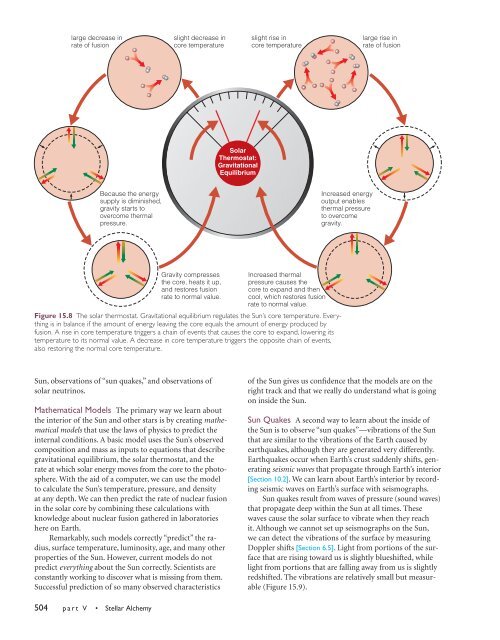Chapter 15--Our Sun - Geological Sciences
Chapter 15--Our Sun - Geological Sciences
Chapter 15--Our Sun - Geological Sciences
You also want an ePaper? Increase the reach of your titles
YUMPU automatically turns print PDFs into web optimized ePapers that Google loves.
large decrease in<br />
rate of fusion<br />
slight decrease in<br />
core temperature<br />
slight rise in<br />
core temperature<br />
large rise in<br />
rate of fusion<br />
Solar<br />
Thermostat:<br />
Gravitational<br />
Equilibrium<br />
Because the energy<br />
supply is diminished,<br />
gravity starts to<br />
overcome thermal<br />
pressure.<br />
Increased energy<br />
output enables<br />
thermal pressure<br />
to overcome<br />
gravity.<br />
Gravity compresses<br />
the core, heats it up,<br />
and restores fusion<br />
rate to normal value.<br />
Increased thermal<br />
pressure causes the<br />
core to expand and then<br />
cool, which restores fusion<br />
rate to normal value.<br />
Figure <strong>15</strong>.8 The solar thermostat. Gravitational equilibrium regulates the <strong>Sun</strong>’s core temperature. Everything<br />
is in balance if the amount of energy leaving the core equals the amount of energy produced by<br />
fusion. A rise in core temperature triggers a chain of events that causes the core to expand, lowering its<br />
temperature to its normal value. A decrease in core temperature triggers the opposite chain of events,<br />
also restoring the normal core temperature.<br />
<strong>Sun</strong>, observations of “sun quakes,” and observations of<br />
solar neutrinos.<br />
Mathematical Models The primary way we learn about<br />
the interior of the <strong>Sun</strong> and other stars is by creating mathematical<br />
models that use the laws of physics to predict the<br />
internal conditions. A basic model uses the <strong>Sun</strong>’s observed<br />
composition and mass as inputs to equations that describe<br />
gravitational equilibrium, the solar thermostat, and the<br />
rate at which solar energy moves from the core to the photosphere.<br />
With the aid of a computer, we can use the model<br />
to calculate the <strong>Sun</strong>’s temperature, pressure, and density<br />
at any depth. We can then predict the rate of nuclear fusion<br />
in the solar core by combining these calculations with<br />
knowledge about nuclear fusion gathered in laboratories<br />
here on Earth.<br />
Remarkably, such models correctly “predict” the radius,<br />
surface temperature, luminosity, age, and many other<br />
properties of the <strong>Sun</strong>. However, current models do not<br />
predict everything about the <strong>Sun</strong> correctly. Scientists are<br />
constantly working to discover what is missing from them.<br />
Successful prediction of so many observed characteristics<br />
of the <strong>Sun</strong> gives us confidence that the models are on the<br />
right track and that we really do understand what is going<br />
on inside the <strong>Sun</strong>.<br />
<strong>Sun</strong> Quakes A second way to learn about the inside of<br />
the <strong>Sun</strong> is to observe “sun quakes”—vibrations of the <strong>Sun</strong><br />
that are similar to the vibrations of the Earth caused by<br />
earthquakes, although they are generated very differently.<br />
Earthquakes occur when Earth’s crust suddenly shifts, generating<br />
seismic waves that propagate through Earth’s interior<br />
[Section 10.2].We can learn about Earth’s interior by recording<br />
seismic waves on Earth’s surface with seismographs.<br />
<strong>Sun</strong> quakes result from waves of pressure (sound waves)<br />
that propagate deep within the <strong>Sun</strong> at all times. These<br />
waves cause the solar surface to vibrate when they reach<br />
it. Although we cannot set up seismographs on the <strong>Sun</strong>,<br />
we can detect the vibrations of the surface by measuring<br />
Doppler shifts [Section 6.5]. Light from portions of the surface<br />
that are rising toward us is slightly blueshifted, while<br />
light from portions that are falling away from us is slightly<br />
redshifted. The vibrations are relatively small but measurable<br />
(Figure <strong>15</strong>.9).<br />
504 part V • Stellar Alchemy
















